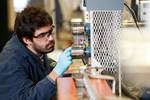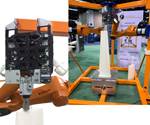Orbital Composites, ORNL collaborate to advance robotic polymer and composite AM
The research will focus on the development of a commercially-ready system capable of robotic overprinting on pre-manufactured non-planar surfaces, with multi-material polymers and continuous fiber.

Orbital's ORB robotic 3D printing platform being installed at Department of Energy’s Manufacturing Demonstration Facility at ORNL. Photo Credit: Orbital Composites, ORNL
It was announced on Sept. 22 that Orbital Composites (San Jose, Calif., U.S.), a start-up company building disruptive industrial-scale digital manufacturing platforms, and Oak Ridge National Laboratory (ORNL; Knoxville, Tenn., U.S.) signed a cooperative research and development agreement to develop out-of-plane, robotic polymer and composite additive manufacturing (AM) technology. The agreement is said to build upon Orbital Composites’ novel ORB platform for robotic neat polymer and continuous-fiber AM platform and ORNL’s expertise in materials science and scaling-up AM systems.
According to ORNL and Orbital Composites, research will focus on the development of a commercially-ready system capable of robotic overprinting on pre-manufactured non-planar surfaces, with multi-material polymers and continuous fiber. It is said this will enable the seamless integration of polymer and composite AM with other processes as well as the transition to industry 4.0 manufacturing strategies. According to both partners, significant energy and materials savings will be realized in this manufacturing technology due to the efficient use of specific manufacturing processes and materials.
“This collaboration will result in technology that can serve a number of industries by incorporating additive manufacturing with complex shapes that weren’t possible to produce through traditional manufacturing methods,” says ORNL’s Vlastimil Kunc, lead researcher on the project. “Integration of multiple manufacturing processes and fusion of digital and physical space will also be a significant step toward industry 4.0 implementation.”
Large-scale, fine-precision, high-speed AM has recently become a reality, says the partners. Orbital’s AM systems, for example, have demonstrated robotic overprinting on a curved surface, and continuous fiber printing with many different matrices.
“The next small step for 3D printing is to combine the innovations of both systems, resulting in the next giant leap in aerospace and automotive manufacturing,” says Cole Nielsen, Orbital’s founder and CTO. “The optimized placement of single fiber tows and low density meshes onto curved surfaces will enable the cost-effective use of AM for serial production.”
Related Content
-
Evident wind blade inspection system automates nondestructive ultrasonic testing
An autonomous, cobot-mounted inspection system combines Industry 4.0 with established ultrasonic technology to rapidly provide repeatable, accurate data and improve overall efficiency.
-
Toray announces growth, investment in carbon fiber composite materials
As part of its 2023-2025 management strategy, Toray projects 42% growth for pressure vessels, 30% growth in carbon fiber composite materials revenue and a doubling of capital investment.
-
Digitizing tools for composites production
Alpex Technologies focuses on industrialization, process and part intelligence and biocomposites in its next generation of tooling systems.















